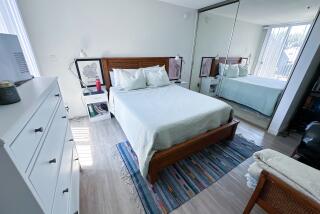Gray’s versatility in home design
- Share via
Obsessing over just the right shade of white or beige for your walls? Why not obsess over gray?
“It is not only chic but more forgiving than white, especially with kids and pets and that one guest who always spills,” says Timothy Guetzlaff, the designer of David Meister and Alan Siegel’s home. Guetzlaff calls gray a “non-color that changes over the day depending on sunshine and cloudiness.” Because the tones shift, people can live with gray for quite a while, he adds, and if they get bored, they can change the furniture or accessories.
Other advantages: Neutral-colored walls lend a sense of serenity. They can leave the spotlight on views or prized possessions. They can better highlight fine materials in furniture. They also allow you to play with texture without getting fussy or busy. Key points to consider in selecting a gray:
Undertones: To find the best color for a room, Guetzlaff suggests looking at the darkest shade on the fan deck or color swatch strip. That will help you determine what color undertones exist in the lighter colors that you’re more likely to use on the wall.
Shopping: “Take that color card when you go looking for rugs, furniture, bedding, even towels,” Guetzlaff says. “If it matches anywhere on that card, it is going to work in the room.”
Finish: An eggshell or a satin paint will reflect its surroundings. On a window wall near greenery or a swimming pool, gray walls will appear greener and bluer. At night, incandescent light will make grays look warmer; halogens and LEDs will make them look cooler.
Yellow: Yellow-toned grays are warm and enveloping. “If you have a sunny bedroom in the morning,” the designer says, “you would want to choose an ivory or yellowish color that goes with that light.”
Green and blue: Grays with green, blue and especially purple recede, making rooms look larger. “It makes your walls and spaces float,” Guetzlaff says. “At night, it looks even more dramatic and works well in a media room, which is always dark.” The ceiling in the Siegel-Meister home is lavender-gray. “It’s the most ethereal shade of all. During the day it looks white, and at night — at night it’s the color of shadows.”
Red: Reddish grays neither recede nor envelope, Guetzlaff says. “They define the surface of the wall.” If you are thinking of painting a bathroom gray, he adds, pinkish grays are the kindest on skin tones in the mirror.
— David A. Keeps


